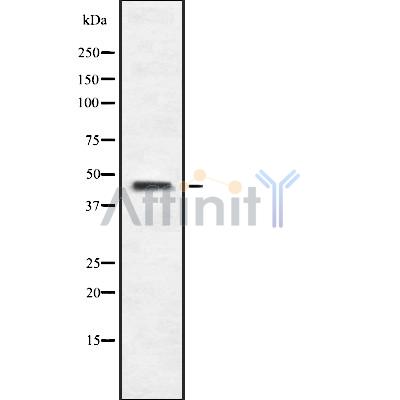ARRS Antibody - #DF8919
| Product: | ARRS Antibody |
| Catalog: | DF8919 |
| Description: | Rabbit polyclonal antibody to ARRS |
| Application: | WB IHC |
| Reactivity: | Human, Rat |
| Prediction: | Pig, Bovine, Horse, Sheep, Rabbit, Dog, Xenopus |
| Mol.Wt.: | 45 kDa; 45kD(Calculated). |
| Uniprot: | P10523 |
| RRID: | AB_2842115 |
Product Info
*The optimal dilutions should be determined by the end user. For optimal experimental results, antibody reuse is not recommended.
*Tips:
WB: For western blot detection of denatured protein samples. IHC: For immunohistochemical detection of paraffin sections (IHC-p) or frozen sections (IHC-f) of tissue samples. IF/ICC: For immunofluorescence detection of cell samples. ELISA(peptide): For ELISA detection of antigenic peptide.
Cite Format: Affinity Biosciences Cat# DF8919, RRID:AB_2842115.
Fold/Unfold
48 kDa protein; Arrestin 1; Arrestin; ARRS_HUMAN; Retinal S antigen (48 KDa protein); Retinal S-antigen; Rod photoreceptor arrestin; RP47; S antigen; S antigen retina and pineal gland (arrestin); S arrestin; S-AG; S-arrestin; SAG;
Immunogens
A synthesized peptide derived from human ARRS, corresponding to a region within the internal amino acids.
Detected in retina, in the proximal portion of the outer segment of rod photoreceptor cells (at protein level).
- P10523 ARRS_HUMAN:
- Protein BLAST With
- NCBI/
- ExPASy/
- Uniprot
MAASGKTSKSEPNHVIFKKISRDKSVTIYLGNRDYIDHVSQVQPVDGVVLVDPDLVKGKKVYVTLTCAFRYGQEDIDVIGLTFRRDLYFSRVQVYPPVGAASTPTKLQESLLKKLGSNTYPFLLTFPDYLPCSVMLQPAPQDSGKSCGVDFEVKAFATDSTDAEEDKIPKKSSVRLLIRKVQHAPLEMGPQPRAEAAWQFFMSDKPLHLAVSLNKEIYFHGEPIPVTVTVTNNTEKTVKKIKAFVEQVANVVLYSSDYYVKPVAMEEAQEKVPPNSTLTKTLTLLPLLANNRERRGIALDGKIKHEDTNLASSTIIKEGIDRTVLGILVSYQIKVKLTVSGFLGELTSSEVATEVPFRLMHPQPEDPAKESYQDANLVFEEFARHNLKDAGEAEEGKRDKNDVDE
Predictions
Score>80(red) has high confidence and is suggested to be used for WB detection. *The prediction model is mainly based on the alignment of immunogen sequences, the results are for reference only, not as the basis of quality assurance.
High(score>80) Medium(80>score>50) Low(score<50) No confidence
Research Backgrounds
Binds to photoactivated, phosphorylated RHO and terminates RHO signaling via G-proteins by competing with G-proteins for the same binding site on RHO (By similarity). May play a role in preventing light-dependent degeneration of retinal photoreceptor cells.
Cell projection>Cilium>Photoreceptor outer segment. Membrane>Peripheral membrane protein.
Note: Highly expressed in photoreceptor outer segments in light-exposed retina. Evenly distributed throughout rod photoreceptor cells in dark-adapted retina (By similarity). Predominantly dectected at the proximal region of photoreceptor outer segments, near disk membranes (PubMed:3720866).
Detected in retina, in the proximal portion of the outer segment of rod photoreceptor cells (at protein level).
The C-terminus interferes with binding to non-phosphorylated RHO. Interaction with phosphorylated RHO triggers displacement of the C-terminus and leads to a conformation change that mediates high-affinity RHO binding.
Belongs to the arrestin family.
Research Fields
· Organismal Systems > Sensory system > Phototransduction.
Restrictive clause
Affinity Biosciences tests all products strictly. Citations are provided as a resource for additional applications that have not been validated by Affinity Biosciences. Please choose the appropriate format for each application and consult Materials and Methods sections for additional details about the use of any product in these publications.
For Research Use Only.
Not for use in diagnostic or therapeutic procedures. Not for resale. Not for distribution without written consent. Affinity Biosciences will not be held responsible for patent infringement or other violations that may occur with the use of our products. Affinity Biosciences, Affinity Biosciences Logo and all other trademarks are the property of Affinity Biosciences LTD.
